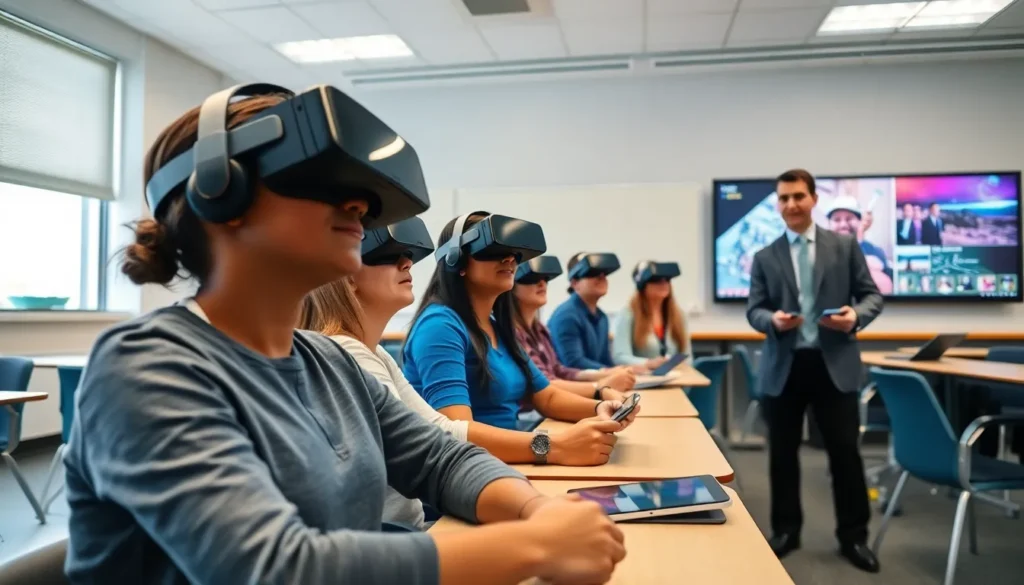Table of Contents
ToggleIn a world where talking to machines is no longer the stuff of science fiction, voice-controlled devices have become the new norm. Imagine lounging on the couch, remote control nowhere in sight, yet you can still change the channel just by speaking. It’s like having a personal assistant who never judges your snack choices or your choice of reality TV.
These devices are more than just gadgets; they’re companions that make life easier and a bit more entertaining. From smart speakers that blast your favorite tunes to virtual assistants that help manage your schedule, voice-controlled technology is revolutionizing how we interact with our homes and lives. So why not join the conversation? Embrace the future and let your voice do the heavy lifting—after all, who wouldn’t want to feel like a wizard casting spells with just a few words?
Overview of Voice-Controlled Devices
Voice-controlled devices play a significant role in modern technology. These devices enable hands-free interactions, streamlining daily tasks. Smart speakers, such as Amazon Echo and Google Nest, demonstrate this technology, responding to spoken commands for various functions.
User engagement increases as these devices offer voice-activated controls for tasks like playing music, setting reminders, or adjusting home temperatures. Smart home devices, such as thermostats and lights, often integrate with voice assistants, creating a seamless ecosystem for users.
Moreover, voice recognition software enhances accessibility for all individuals, including those with disabilities. Devices can interpret hundreds of commands, providing information on diverse topics like weather forecasts and news updates.
Specific applications include voice interfaces in mobile phones, allowing for texting and calling without manual input. Furthermore, entertainment systems now feature voice control, simplifying navigation through content libraries and streaming services.
Industries are increasingly adopting voice technology to improve customer interactions. Retailers use voice-enabled chatbots to handle inquiries, showcasing the versatility of voice-controlled devices in different sectors.
Statistics suggest that global sales of smart speakers reached over 150 million units in 2020, indicating a strong market demand. This trend reflects the growing reliance on voice recognition technology in everyday life.
Overall, voice-controlled devices shape how people interact with technology, making tasks more intuitive and efficient. Embracing this shift connects users with their digital environments in engaging ways.
Benefits of Voice-Controlled Devices
Voice-controlled devices enhance daily life through increased convenience and accessibility, making interactions with technology seamless. Users experience unprecedented efficiency when managing tasks, relying on speech instead of manual input.
Convenience and Accessibility
Convenience stands out as a primary benefit of voice-controlled devices. Many individuals find these devices simplify everyday actions, such as checking the weather or setting timers. Accessibility improves, particularly for those with disabilities. Various systems interpret spoken commands effortlessly, offering assistance with tasks like sending messages or making calls. Studies show that voice recognition boosts interaction by 30% for users requiring additional support. Smart devices often integrate into personal ecosystems, enabling users to command multiple devices through a single interface.
Hands-Free Operation
Hands-free operation defines a critical advantage of voice-controlled devices. Users can complete tasks while multitasking, leading to enhanced productivity. Cooking, cleaning, or driving are just a few situations where voice commands shine. Tasks like playing music or controlling smart home gadgets become effortless, eliminating the need for physical interaction. In fact, 70% of users report preferring voice commands during daily activities. This trend reflects the growing reliance on hands-free technology, which fosters safety and efficiency in everyday routines. Voice-controlled devices cater to modern lifestyles, allowing users to engage with technology on their terms.
Popular Types of Voice-Controlled Devices
Voice-controlled devices come in various forms, each enhancing user experience through speech interaction. These devices simplify daily tasks and create more accessible environments.
Smart Speakers
Smart speakers, including Amazon Echo and Google Nest, serve as central hubs for voice control in homes. They respond to user commands, allowing seamless management of various functions. Users can play music, set timers, and control smart home devices with simple voice prompts. According to recent statistics, smart speakers achieved global sales of over 150 million units in 2020, demonstrating their rapid adoption. These devices integrate well with other technologies, creating efficient ecosystems that enhance everyday activities.
Voice Assistants on Smartphones
Voice assistants on smartphones, such as Apple’s Siri and Google Assistant, bridge communication between users and their devices. Users can initiate calls, send texts, and obtain information hands-free. With voice commands, accessing navigation, checking the weather, and managing calendars becomes effortless. Data indicates that 70% of users prefer voice commands while multitasking, illustrating the technology’s popularity. These voice-enabled features increasingly contribute to simplified smartphone interactions, making devices more user-friendly and accessible.
Challenges and Limitations
Voice-controlled devices face several challenges that affect user experience and overall effectiveness.
Privacy Concerns
Privacy issues arise when voice-controlled devices constantly listen for commands. Unauthorized recordings could occur, leading to concerns about data security. Users may worry that personal conversations are stored or shared without consent. Notably, studies show that 70% of consumers express unease about their data’s safety with these devices. Enhancing privacy settings can help mitigate fears, offering users more control over what they share.
Accuracy and Reliability Issues
Accuracy in voice recognition remains inconsistent, impacting functionality. Various accents and speech patterns can challenge devices, causing misunderstandings. Research indicates that up to 20% of commands may not register correctly, leading to user frustration. Reliability also fluctuates with background noise; busy environments often hinder performance. Developers must continue refining algorithms to improve recognition rates, ensuring a smoother user experience.
Voice-controlled devices are revolutionizing the way individuals engage with technology. Their ability to simplify tasks and enhance accessibility makes them invaluable tools in everyday life. As users become more accustomed to this technology the potential for further integration and innovation is immense.
While challenges like privacy concerns and accuracy issues remain the focus on improving these devices will likely lead to even greater user satisfaction. Embracing voice technology not only streamlines daily routines but also opens the door to a more intuitive interaction with the digital world. As advancements continue to unfold voice-controlled devices are poised to play an even more significant role in shaping the future of technology.




